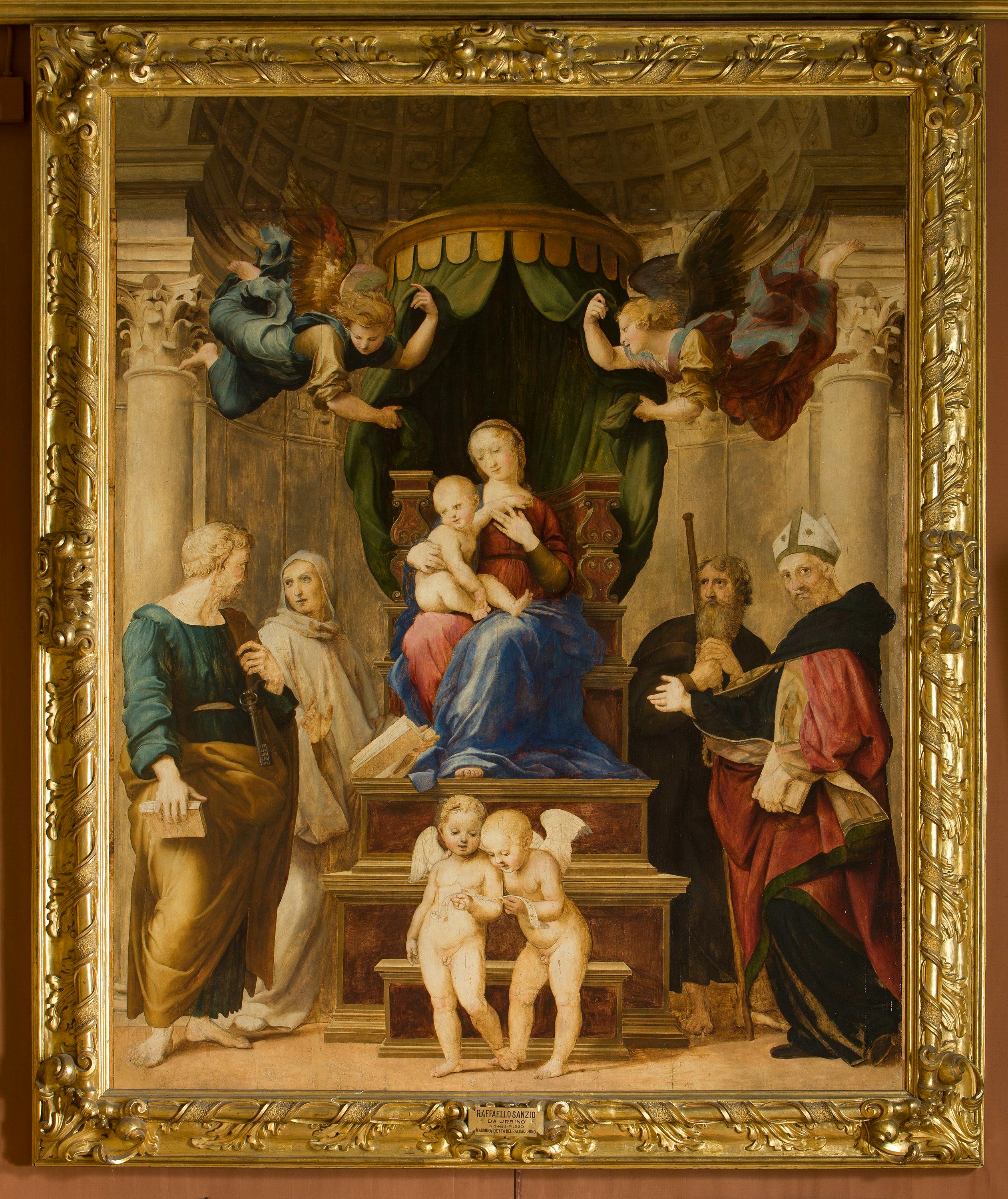Madonna and Child Enthroned with Saints Peter, Bernard, Augustine and Ranieri, known as Madonna del Baldacchino
Raphael (Urbino 1483 – Rome 1520)
The execution of this altarpiece, which is the only large altarpiece of public use known to date from Raphael's Florentine period, has been linked to documents from 1506 mentioning the commission for a chapel sponsored by the Dei family in the church of Santo Spirito, to a letter from 1508 in which Raphael states that he was painting an altarpiece, and to Giorgio Vasari's testimony in his biography dedicated to the artist from Urbino. Summoned by Pope Julius II to Rome to paint in the flats, Raphael did not complete the work, and later the Sacred Conversation by Rosso Fiorentino, now exhibited in the Iliad Room, was placed in the Dei Chapel. After Raphael's death, the Madonna del Baldacchino was purchased by Baldassarre Turini, an apostolic official (i.e. a sort of minister of the economy, who dealt with the proceeds of ecclesiastical charity and other taxes), and transferred to his family's chapel in Pescia Cathedral. It remained there until 1697, when it was bought by Grand Prince Ferdinando de' Medici, son of Grand Duke Cosimo III and heir to the grand ducal throne. The sale triggered violent reactions from the people of Pescia, who were deeply attached to the cult of Raphael's Virgin, so much so that it had to be moved at night to Florence, replacing it with a copy made by the Florentine Pier Dandini. When it arrived at Palazzo Pitti, the altarpiece was hung in Ferdinando's flat, in the south wing of the first floor (where the Royal and Imperial Apartments are today) next to Fra Bartolomeo's Salvator Mundi, according to a pairing that was respected even later, in the Lorraine era, when both panels were moved to the Room of Saturn where they remain to this day. To adapt it to the princely collection and the carved and gilded wooden frame that it still has, the painting was enlarged at the top by court painter Niccolò Cassana, who added the crowning of the cone-shaped canopy and, in the background, the domed ceiling with gilded lacunars similar to that of the Pantheon. Raphael's original composition is centred on the high throne on which Mary and Child sit, surmounted by the curtain supported by two angels. Four saints are gathered around the mother and child, for each of whom the painter designed a different expression. St. Augustine, in the foreground on the right, stands out in particular among them because, unlike the others, he addresses the viewer directly, pointing at the sacred group. Two little angels, bottom centre, unroll a scroll chanting songs of glory. The entire composition stands out for the harmony in the arrangement of the figures, the extraordinary delicacy of the sentiments represented as well as for the conscious ability to create an airy and monumental, yet at the same time very measured space, demonstrating how Raphael had by this time fully mastered the models he had learnt in Florence, comparing himself with the mastery of Fra Bartolomeo, Leonardo and Michelangelo. Some of those inventions, such as the windswept angels, that the painter would later develop in the Roman works of later years are already present here. The restoration work carried out at the Opificio delle Pietre Dure workshops between 1987 and 1991 established that the painting has varying degrees of advancement in execution, but at no point is it fully complete, thus confirming Vasari's old testimony that it was left unfinished by the artist.
R. Spinelli in Il Gran Principe Ferdinando de' Medici (1663-1713). Collezionista e mecenate, catalogo della mostra (Firenze 26 giugno – 3 novembre 2013), a cura di R. Spinelli, Firenze, 2013, p. 268; S. Padovani in I dipinti della Galleria Palatina e degli Appartamenti Reali. Le Scuole dell’Italia Centrale 1450-1530, Firenze 2014, pp. 331-342
